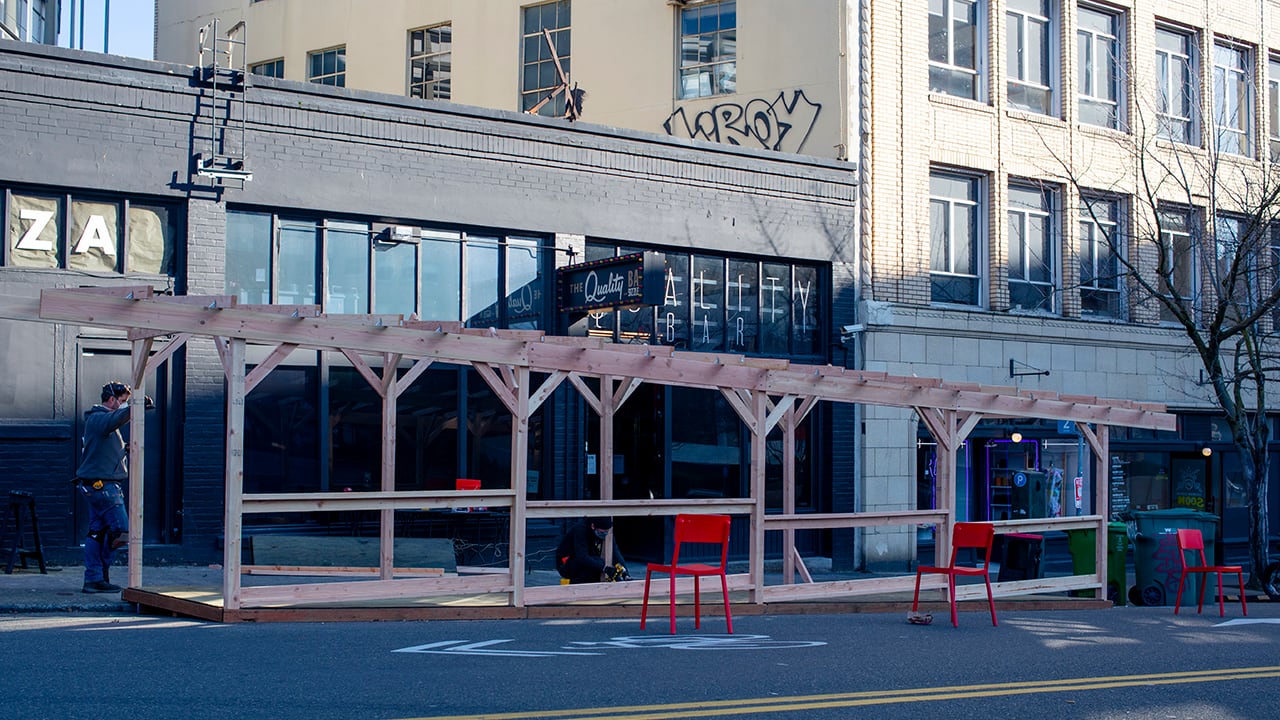You know the old Western cliché about the hated lawman who walks into an outlaw saloon? The piano player stops the music. Angry eyes stare out over shot glasses. Someone hawks into a spittoon.
That's what it felt like when Dr. Dean Sidelinger arrived March 18 at the virtual meeting of the Oregon Liquor Control Commission.
That panel regulates the sale of alcohol at bars and restaurants. It also is the sounding board for complaints from booze slingers—and often a friendly ear, given that one of the commissioners owns Amalfi's Italian Restaurant in Northeast Portland, and another is a descendent of the Maletis beer distribution family.
For more than a year, the commission has been hearing about the misery of Oregon's shuttered bars and restaurants. The hospitality industry lost 25 years of job growth in the nine months after the COVID-19 pandemic descended. Restaurateurs place much of the blame on Gov. Kate Brown and her health officials, who repeatedly ordered dining rooms shut down and are now gradually reopening them.
Among those officials? Sidelinger, the state's epidemiologist. So he was in for a grilling.
For the better part of an hour, in unusually confrontational terms between state agencies, OLCC commissioners demanded he justify keeping bars and restaurants closed. The thrust of their questions: If Oregon can't trace COVID outbreaks back to restaurants, where's the evidence that such establishments present a public health risk?
Epidemiologists like Sidelinger are in broad agreement: Bars spread COVID-19. Publicans feel they're being scapegoated while they lose their shirts. That was the setup for a clash between public health and the bar business, which played out in the form of questions and answers.
To listen to the full meeting, visit wweek.com later this week. This exchange—between Commissioner Jennifer Currin, a lawyer from Pendleton, and Sidelinger—is a good sample of how the hour went. It has been edited for brevity and clarity.

Jennifer Currin: My understanding, from what I've heard from the governor, has been that the top super-spread areas would not be bars and restaurants. We've heard of a lot of workplace outbreaks, large family home gatherings, Super Bowl parties, New Year's parties, Thanksgiving holidays, prison outbreaks. Those types of things have been the largest reasons for the spread. Can you confirm any of that?
Dean Sidelinger: You're right that bars and restaurants aren't near the top of the list. And I think that's because we've really limited the indoor activities in those places. The restrictions have had tremendous negative economic impacts on businesses but have limited that spread.
Currin: The U.S. Centers for Disease Control and Prevention website makes recommendations about what's more risky. You know: Outdoor dining is less risky, this is more risky. But is there a way to quantify that? It's one thing to say it's more risky. Can you quantify that risk for us?
Sidelinger: Indoor dining shows a significant association with increase in cases starting at 41 days. And a subsequent increase in deaths after that. The association with restarting indoor dining and increase in cases is not seen with the restarting of other sectors.
Currin: I didn't hear a quantification, such as: We will see 2% more community spread. I want to know. We're putting in policies that will reduce the spread and reduce the risk of indoor dining. We limit table sizes. Stay apart, wear masks, sanitize. Why isn't that enough?
Sidelinger: But some of the tools we can't use in the setting of a bar or a restaurant. Someone who comes in to eat or drink has to remove their mask while they're eating or drinking. I will say that we see an increase in deaths 41 days after opening indoor dining by 1.1%. It goes up to 2.2% 61 days after. And a 3% increase in deaths 81 days after reopening indoor dining.
Currin: Dr. Sidelinger, I have to tell you, our bars and restaurants were shut down in November and our spike—the state of Oregon—continued well after that. We can't blame bars and restaurants for that dramatic increase.
Sidelinger: Oregon continues to lead the way with low cases and death rates in this pandemic. And it's because of those restrictions that were in place. Otherwise, that dramatic increase that we saw through the month of November—when bars and restaurants were open—would have continued into the winter. And we would have been in a much different place right now and not talking about reopening additional activity.
Correction: This story incorrectly explained OLCC commissioner Matt Maletis' connection to the beer distribution business. He does not have a financial relationship with the company.

